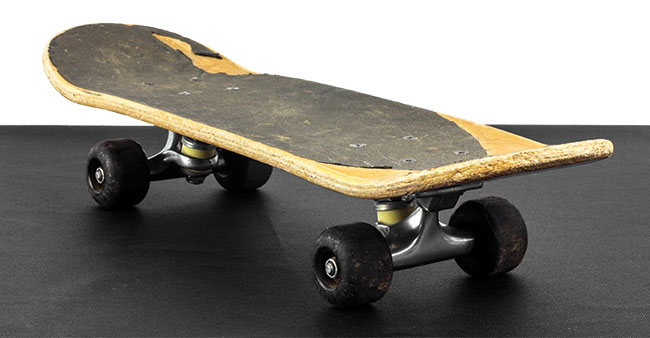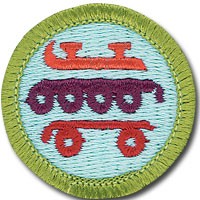There is a good chance that you will see somebody on a skateboard almost every day. Skateboarding started more than 50 years ago and has changed into a sport and a lifestyle that lets you exercise your body while expressing your personality. Skateboarding is a cheap way to get around, a great exercise and a sport with very few rules but has tons of tricks to master. Some tricks should be left to the pros, but you can easily build up and learn some cool tricks for yourself.

Rodeo Station number one
For this activity, each scout should bring their own helmet and skateboard. You could set up a few stations for this activity. At station 1 have volunteers do a safety check on each boy’s skateboard and make sure the wheels and fasteners are adjusted properly. Also check that each boy has a helmet and is wearing it properly, which means it should fit snugly, with the front edge low on his forehead. Each boy should have knee pads and elbow pads to protect them if a fall happens. Also you might need to bring along a few ‘loaner’ skateboards for those kids who may not have their own boards.
Safety is very important
The next station should teach them the rules of good and safe skateboarding. Here are some tips from the Consumer Product Safety Commission – Like other sports activities, skateboarding has risks. Vehicle traffic, trick riding, and excessive speed can lead to collisions, loss of control, and falls. Even experienced riders have been injured and killed. Take knowledge to the extreme, and follow these important tips for safer riding:
● Wear protective gear when riding—especially a helmet. Wearing a helmet can mean the difference between life and death. Don’t become another statistic.
● Stay clear of moving vehicles. Some of the most common and severe skateboarding accidents involve collisions with moving vehicles. Don’t ride where you are likely to encounter traffic. Never hitch a ride (“skitch”) onto a moving vehicle.
● Inspect/adjust your board before you ride. Always check for excessive play (looseness) and any broken or cracked parts. Serious defects should be fixed by a qualified repair shop.
● Ride during the day. Avoid riding at dusk and dawn or in other low-light conditions where you cannot see or be seen easily by vehicles.
● Inspect your riding terrain. Skateboarders should inspect the area where they will be riding for holes, bumps, rocks, and debris.
● Never ride alone. Accidents happen. Ride with friends and bring a phone. Children under 8 years old should be supervised closely.
● Ride wisely. Don’t ride faster than you can handle. You can lose control of your skateboard at any speed. Never lie down on a skateboard in motion.

Learn how to fall
Learning how to skateboard and how to fall is a good thing to teach the kids before the rodeo begins. The next station should teach the kids about how to fall. When learning how to fall, remember that protective equipment is not a guarantee of avoiding injury. To fall correctly, it is almost always better to fall forward as opposed to falling backward. When executing a “bail” or a controlled fall, it is typically better to fall and go with the motion than it is to try to prevent yourself from falling by trying to stick out an arm or leg to brace yourself. A roll should start with elbow or knee contact with the ground and then a rolling motion across your back, ending with ground contact with the opposing elbow or knee. Another station should teach about speed wobbles. Speed wobbles happen when a skateboard starts shimmying from side to side. If you can’t control the shimmying, you could be thrown from the board. To avoid speed wobbles:
● Ride forward on the board and crouch slightly.
● Use a longer board.
● Use a board with wheels that are farther apart.
● Be sure trucks, wheels, nuts, and mounting screws are tightened properly.
Final Thoughts
As a final thought besides offering valuable lessons, consider sending kids home with gifts. Perhaps you could give each child who completed the rodeo a “skateboard driver’s license” and a grab bag of items like school supplies. Also consider giving away some gently used skateboards to be given away in a drawing. Another great giveaway is skateboard helmets. Local hospitals, brain-injury charities and skateboard clubs might have helmets available that you can give kids who don’t have decent helmets or who have outgrown their helmets.